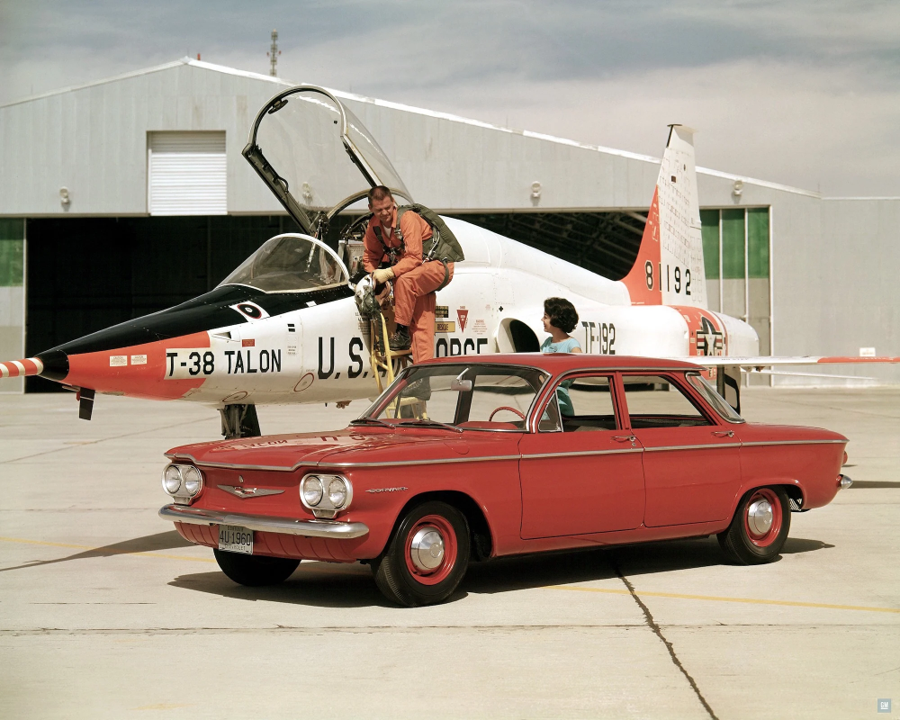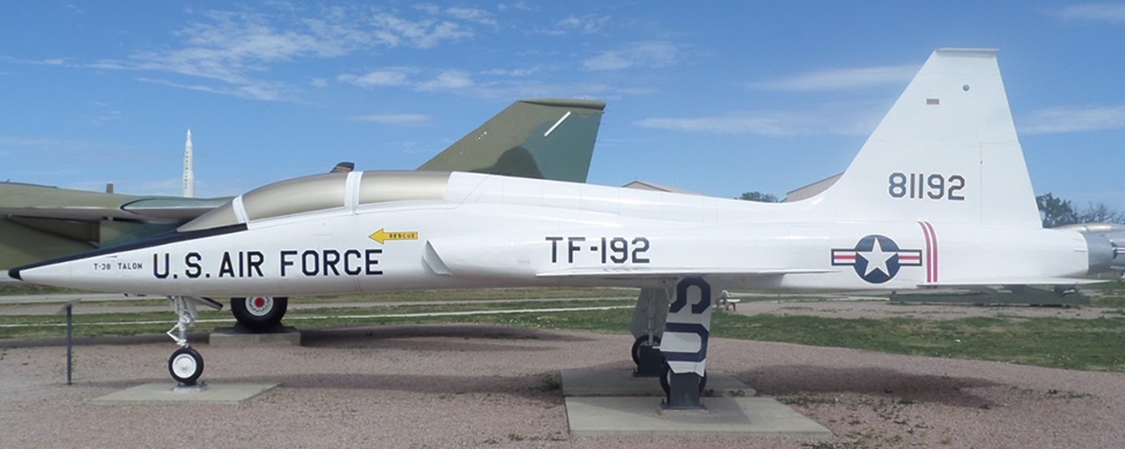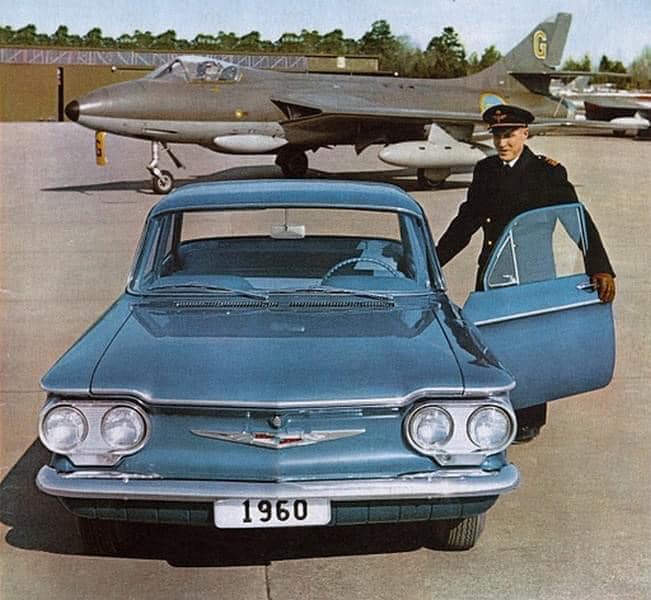Corvair Fl(air)
Cars and airplanes have been photographed together in advertisements almost since the birth of their respective technologies. Originally, airplanes in automobile advertising were a subtle way to illustrate luxury and reinforce the freedom of travel and the promise of adventure through ownership of the marketed vehicle. After World War II, airplanes in car ads came to represent science, technology, and performance, again communicating the same aspects to the advertised product. This last theme appears to be at the heart of the images that follow below. However, whether by design or otherwise, the images also illustrate products that almost concurrently made automotive and aviation history.

Gamechangers: Corvair 700 Sedan and a Northrop YT-38 at Edwards Air Force Base, CA, 1960. (Courtesy of GM Heritage Center)
The first image is from a General Motors advertisement from calendar year 1960 in which a Chevrolet Corvair 700 Sedan is parked on an airfield ramp with the second pre-production YT-38 aircraft. Both products were gamechangers at the time. The revolutionary Corvair was introduced in the fall of 1959 as General Motors’ response to the increasing popularity of small European economy cars with U.S. buyers in the late 1950s. Unlike its domestic contemporaries from Ford (Falcon) and Chrysler (Valiant), the Corvair was powered by a rear-mounted and air-cooled engine, thus following the lead of models from major import competitors Volkswagen and Renault. While it was not the first American car equipped in this way, it was the first mass-produced rear-engine and air-cooled car in the U.S., with total production of 1.8 million vehicles. This number places it at the top of the list of American cars configured as such.
The YT-38 was built by Northrop Aircraft of Hawthorne, CA (now Northrop Grumman) as its entry in the U.S. Air Force (USAF)-led competition for the world’s first supersonic training aircraft. The T-38 was scaled up as a two-seat aircraft from a single-seat design that Northrop had originally begun development as a private venture to produce a lightweight and low-cost fighter aircraft. The parallel histories of the Corvair and T-38 may therefore have influenced the decision to photograph them together, as the image in the ad was captured shortly after both vehicles chalked historic milestones in 1959. In that year, production of the 1960 Corvair began in July, while the first YT-38 (serial number 58-1191) made the type’s first flight earlier in April of 1959 at the air Force Flight Test Center at Edwards Air Force Base (AFB), CA. Edwards is undoubtedly the location in which the Corvair and YT-38 are seen in the ad, since flight testing of a total of five YT-38 aircraft was ongoing at the time that the ad was publicized.
Interestingly, the Corvair and YT-38 were developed by teams led by legendary designers. The Corvair was largely conceived and planned by Edward N. Cole, an engineer and father of the post-World War II Cadillac and Chevy V-8s. Cole eventually became president and CEO of General Motors from 1967-1974 and remained a booster of the Corvair until his death in 1977. The T-38’s design team was led by Edgar Schmued, who was famous for his work with North American Aviation (now absorbed into Boeing) on developing the company’s famous P-51 Mustang fighter of World War II. Afterward he was the principal designer of North American’s Korean War-era F-86 Sabre and followed that successful design with the F-100 Super Sabre, mainstay of the USAF’s fighter fleet into the 1960s.
After its introduction for 1960, the Corvair’s accolades included being named Motor Trend’s Car of the Year. Offered in several versions, it had decent sales until Ford’s Falcon began to overtake the Corvair as the choice for economy-minded small car buyers. Further damage to Corvair sales was the result of nationwide publicity regarding alleged design defects in 1960-1963 Corvairs from then-budding consumer advocate Ralph Nader. At the same time Ford’s introduction of the Mustang, whose lines and performance contributed to it outselling restyled and sportier second-generation models of the Corvair that became available in the 1965-66 model years, was arguably the major blow to the Corvair line. General Motors developed the Camaro for introduction in 1967 as its own “ponycar” to compete against the Mustang. With all of that headwind, Corvair production was officially directed to wind down until finally ending in 1969.
Regarding the YT-38, after testing was completed at Edwards AFB, production aircraft were designated T-38A Talon and accepted into service in March 1961. The T-38 has since been utilized to train over 70,000 pilots for the USAF and several foreign military services. While a long overdue replacement for the T-38 is being developed in the form of the Boeing Saab T-7A Red Hawk, over 400 are still in service with USAF along with smaller numbers flying with the U.S. Navy as well as the German and Turkish air forces. Northrop also produced over 3,000 single seat fighters designated F-5 from which the design of the T-38 was based. The F-5 became a popular aircraft for international air forces. With upgrades over the years it remains in use for specialized training with the U.S. Navy and is still front-line equipment in the military forces of several countries today.

After completing service in the USAF, YT-38 58-1192 is now on display at the South Dakota Aerospace Museum at Ellsworth Air Force Base near Rapid City, SD. (Courtesy of South Dakota Aerospace Museum)
When the last of 1,187 new T-38s was delivered in 1972, another milestone in the Corvair’s history also occurred in that same year. In July of 1972, the National Highway Traffic Safety Administration (NHTSA) issued its findings from a two-year study of the handling of the 1963 Corvair, which was at the heart of the safety issue with the car as previously identified by Ralph Nader. The study included four contemporaries of the 1963 Corvair – a Ford Falcon, Plymouth Valiant, Renault Dauphine, and Volkswagen Beetle. The study also included an example of a second-generation Corvair, consisting of several restyled and improved models which were produced from 1965-1969. Unlike the previous generation of Corvairs, which had a swing-axle rear suspension that was a major safety issue per Nader’s book (including the 1963 test car), the second-generation car was equipped with a completely redesigned independent rear suspension. The study concluded as follows: “The handling and stability performance of the 1960-1963 Corvair does not result in an abnormal potential for loss of control or rollover and it is at least as good as the performance of some contemporary vehicles, both foreign and domestic.”

Another pairing of advanced technologies: Corvair 700 Sedan and a Hawker Hunter (J 34) of the Flygvapnet (Swedish Air Force), probably at Säve Air Base, Sweden. (Courtesy of Svammelsurium)
The original source of this second image of another Corvair 700 sedan and a then-current military aircraft is unknown, but it seems likely that it was also developed as a car advertisement at the same time as the prior ad. In the event that the image was developed for marketing material, the aircraft in the background and its markings immediately identify it as belonging to the Flygvapnet, or Swedish Air Force. Per the previous ad, it can then be assumed that the target of the marketing effort was Swedish car buyers. As described in a previous article in CarShowSafari.com, American cars have been hugely popular in Sweden for many years. The extent of their popularity is illustrated in that one Swedish city hosts an annual car show that is the largest gathering of American automobiles in the world, drawing up to 22,000 cars over a 3-day period.
In perhaps following the theme of the first ad, the aircraft in this second image is a British Hawker Hunter fighter that was one of 120 of its type delivered to the Swedish Air Force from 1955-1957. Hawker Aircraft was particularly notable as the manufacturer of the Hawker Hurricane fighter of World War II. The Hurricane and the Supermarine Spitfire became legends for successfully defending England against the German Luftwaffe during the Battle of Britain. Hawker continued its excellence in fighter design which became apparent when the first Hunters became operational with Britain’s Royal Air Force in the mid-1950s. Its speed and maneuverability were among its assets that caught the attention of the Swedish Air Force as well. Air force leaders saw the Hunter as the answer to their immediate need for an advanced fighter aircraft until the country’s home-grown Saab Draken design was ready for operational service in the early 1960s. As a result, Sweden was one of the first customers for the Hunter F.4 export model which was designated J 34 by the Swedish military. Other Hunter models were exported to 20 other countries as well, resulting in production totaling 1,972 Hunters for the British Royal Air Force, Royal Navy, and international users. Because of its reliability and adaptability to many roles, the Swedish Hunters served until 1969, with the last operational Hunters in worldwide military service being retired by the Lebanese Air Force in 2014. Unfortunately, the operational period of the J 34 in the photograph, serial number 34051, did not come close to matching either of the aforementioned retirement dates. It crashed and was destroyed on April 30, 1964 during takeoff from Björko, Sweden, with pilot Jan-Lennart Swanström successfully ejecting from the aircraft.
Some notes on the presence of the Corvair in the second image further underscore the love of American cars in Sweden. In 2025 there are 214 Corvairs on the active register in that country per the website Car.info Sweden (https://www.car.info/en-se/chevrolet/corvair). The website contains a breakdown of active Corvairs by generation, model, and year, and also includes a number of pictures of the actual cars. There is also an active car club in Sweden called Corvair Club Sweden that was founded in May of 2014. Its website (https://corvairclubsweden.se/) offers English translation of its contents. Perhaps surprisingly, some of the cars on the current Swedish register and car club owner’s vehicles may not have been imported from the U.S. The reason is that General Motors shipped a number of 1960-66 Corvairs in “CKD” (“Completely Knocked Down”) condition to the company’s assembly plants in Bienne, Switzerland, and Antwerp, Belgium. These locations were the sites where final assembly of these and other General Motors cars took place that were to be sold in European markets. Company executives had high hopes for strong demand for the Corvair in Europe, and although figures are not readily available, various histories have reported that sales were very disappointing. Yet despite the tumultuous history of the Corvair, over the years it has become one of the most unique and beloved car makes for car enthusiasts, and its connection to aviation history only adds to its appeal.

